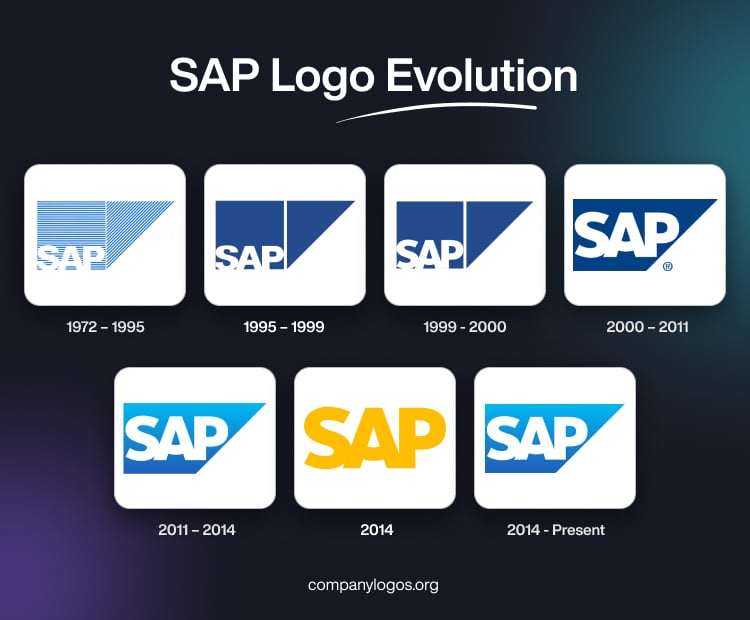
SAP SE was founded in 1972 in Germany by five former IBM engineers, and it has since become one of the world’s leading enterprise software companies. The German expansion of SAP is Systeanalyse und Programmentwicklung, which means System Analysis and Program Development. As the business has evolved, so has its visual identity. The SAP logo, in particular, has undergone a fascinating transformation. It reflects both changing design trends and the company’s enduring commitment to innovation and clarity. The article delves into the various changes undergone by the SAP logo over the years, among other details of the company.
The Genesis of the SAP Logo (1972 – 1995)
The very first SAP logo emerged soon after the company was founded. Designed in the early 1970s, this logo was reportedly crafted on the kitchen table of one of the founders’ homes in rural Germany. It showed a humble beginning emblematic of the startup ethos. The logo’s design drew inspiration from IBM and other technology companies of its era. Featuring blue and white stripes as the background, the logo conveyed a sense of sophistication and technical precision.
The letters “SAP” appeared in white, written in a bold sans-serif font, and were positioned prominently within the box at the bottom. A blue triangle accompanied the square on its right side to symbolise forward movement, growth, and future orientation. It was a subtle but meaningful touch for a tech startup. Besides, the logo’s geometric complexity was typical for enterprise tech brands of the period.
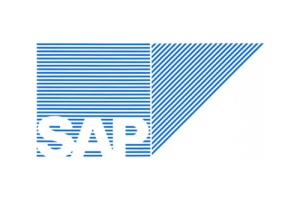
(1995 – 1999)
By the mid-1990s, SAP had achieved considerable international growth. And to enhance legibility and align with modern branding standards, SAP streamlined its logo. The striped square and triangle background became flat and solid dark blue. This made the “SAP” wordmark more legible and contemporary. This era established the foundational silhouette that is still recognisable in SAP branding today.

(1999 – 2000)
The 1999 logo update retained most of the design elements of the previous logo. However, it introduced the “smiling A” by changing the horizontal stroke in the letter “A” to an arched one. Curved slightly upward, the logo added friendliness to the otherwise stoic identity.
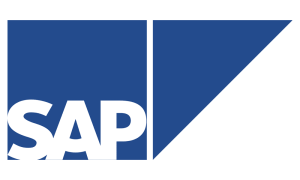
(2000 – 2011)
A significant revamp occurred in 2000, as the tech world entered a new millennium. The square and triangle were now seamlessly merged to reflect unified solutions and operational integration. These were values at the heart of SAP’s product philosophy. The typeface of the wordmark grew bolder, and the logo exuded a stronger sense of authority and professionalism.
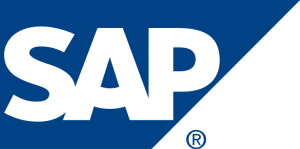
(2011 – 2014)
In 2011, the SAP logo retained its geometric silhouette and “SAP” lettering. However, it did away with the solid dark blue background and brought in a modern blue gradient—dark at the base, light at the top. This choice improved digital readability and established a sleeker and more versatile emblem.
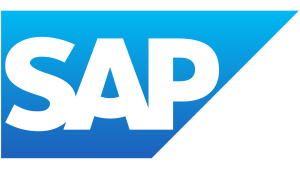
(2014)
In late October 2014, SAP briefly experimented with a bold departure. The logo was reimagined in gold, wherein it was either featured in gold letters on a transparent background or in white letters on a gold background. Also, the historic square and triangle were dropped to give the brand a minimalist and optimistic feel.
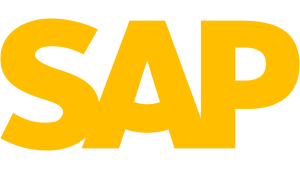
(2014 – Present)
Following feedback from employees, customers, and stakeholders, SAP swiftly reverted to the familiar blue version. This reversal highlighted the symbolic value and deep brand recognition the classic blue logo had accrued over time.
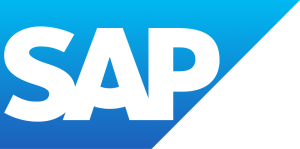
The Elements of the SAP Logo
Font
The familiar wordmark in the SAP logo is rendered using a classic, bold sans-serif typeface in uppercase. Some of the strokes have been modified to give the logo a “flavour.” For instance, the arched horizontal line in the letter “A” resembles a smile.
Colour
The SAP logo employs the colour blue, as the colour is associated with information, mental activity, and software engineering. However, white is often the colour of the wordmark.
The History of SAP
SAP was founded on April 1, 1972, in Weinheim, Germany, by five former IBM engineers—Dietmar Hopp, Hasso Plattner, Claus Wellenreuther, Klaus Tschira, and Hans-Werner Hector. Their vision was to develop standard software for real-time data processing that would integrate business processes across organisations. It was a novel concept at that time when most business software solutions were isolated and siloed.
Initially, SAP operated as a private partnership and worked closely with early customers such as the German subsidiary of Imperial Chemical Industries (ICI). It often sat side-by-side with users to tailor software precisely to business needs. Their first commercial product was launched in 1973 called the RF financial accounting system. It was the precursor to what would be known as SAP R/1—a suite of modules offering integrated financial and inventory management.
By 1976, SAP had formalised as a GmbH (limited company) and moved its headquarters from Weinheim to Walldorf, Germany, where it remains today. Its customer base steadily expanded, with clients such as Siemens and BMW. The expansion was driven by the company’s pioneering approach of real-time data integration and process standardisation.
In 1979, SAP launched SAP R/2, a second-generation mainframe-based software system that expanded capabilities into materials management and production planning. This system gained significant stability and traction through the early 1980s and helped SAP grow its customer base to approximately 200 companies inside and outside Germany.
SAP transformed itself into a public company, SAP AG, in 1988, and listed its shares on the Frankfurt and Stuttgart stock exchanges. Around this time, it began broadening its international reach by opening offices across Europe and the United States.
The most significant milestone came in 1992 with the release of SAP R/3, a client-server architecture that modernised SAP’s software for the emerging networked computing era. This brought expanded enterprise resource planning (ERP) functions and was quickly established as the global standard for business software.
Throughout the 2000s, SAP introduced several new products and pursued strategic acquisitions to broaden its portfolio beyond ERP into areas like business intelligence (with Business Objects in 2008) and information management (with Sybase in 2010). It also launched mySAP.com in 1999, which combined e-commerce solutions with existing ERP modules, thereby pushing SAP into the digital age.
In 2011, SAP introduced SAP HANA, an innovative in-memory database platform that revolutionised how businesses handle and analyse data by enabling real-time insights. More recently, SAP has focused on cloud computing, AI, and machine learning. It emphasises the integration of its over 100 software solutions into a fully digital intelligent enterprise suite.
SAP is based in Walldorf, Germany, with more than 105,000 employees worldwide and over 230 million cloud users. It remains a dominant player in enterprise software and is consistently innovating in areas such as mobility, cloud services, and in-memory computing.
Interesting Facts About SAP
- SAP was founded in 1972 by five former IBM engineers in Germany. The five were Dietmar Hopp, Hasso Plattner, Claus Wellenreuther, Klaus Tschira, and Hans-Werner Hector.
- Its first office was located in Weinheim, and it began as a small startup before evolving into a global software powerhouse.
- SAP is widely credited with pioneering Enterprise Resource Planning (ERP) software, thereby transforming how businesses manage operations.
- SAP’s R/2 (mainframe) and R/3 (client-server) systems became industry standards in enterprise software during the 1980s and 1990s.
- SAP is the third-largest independent software company in the world, after Microsoft and Oracle.
- SAP solutions are used in virtually every major economy and industry, with customers in over 180 countries.
- Over 99 of the 100 largest companies in the world use SAP products in some form.
- SAP software touches over 77% of the world’s transaction revenue, which shows its vital role in global commerce.
- The company is heavily invested in cloud computing with products like SAP S/4HANA Cloud, SAP Business Technology Platform, and SAP SuccessFactors.
- SAP has acquired several companies to enhance its cloud and business services, including SuccessFactors, Concur, Ariba, and Qualtrics.
- SAP developed its own in-memory database platform, HANA, which enables real-time data processing and analytics.
- SAP offers tools to help companies measure and manage their environmental impact, including carbon tracking in supply chains.
- SAP offers industry-specific solutions for everything from manufacturing and finance to healthcare and utilities.
- SAP is central to digital transformation initiatives globally. It helps businesses streamline operations and improve agility.
- Hasso Plattner, one of the original founders of SAP, continues to serve as the chairman of the company’s supervisory board and is a key figure in its strategic direction.
Finally
The SAP logo’s journey has been remarkable. It shows the journey of the company from its kitchen-table origins to its present global iconic status. It illustrates both the changing landscape of software branding and the enduring need for consistency. SAP’s careful stewardship of its visual identity has helped it become a trusted name in business technology. Each logo update of SAP reflects a balance between modernity and respect for a half-century-old legacy.